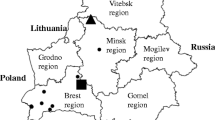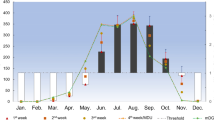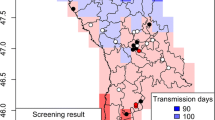Abstract
After the repeated demonstration of Dirofilaria repens infections in German dogs, D. repens and Dirofilaria immitis DNA was detected in mosquitoes trapped in 2011, 2012 and 2013 in northeastern and southwestern Germany within the framework of culicid monitoring projects. As temperature is the most important factor dictating the extrinsic development of dirofilarial larvae in the potential vector, data of the German Weather Service (DWD) were analysed for the regions where the positive mosquitoes had been collected. Based on the mean daily temperatures recorded by weather stations most closely to the collection sites of the mosquitoes, it can be concluded that the mosquitoes were trapped in time periods that allowed for the completion of the developmental cycle of the worms in the mosquitoes and a subsequent transmission to a vertebrate host. The results of this study confirm the principal climatic suitability of certain German regions for the establishment of natural dirofilarial transmission cycles. Moreover, the theoretical climatic considerations, together with findings of D. repens infections in German dogs and mosquitoes, strongly suggest that the continuing spread of at least D. repens from its traditional habitats in the Mediterranean has reached southwestern and northeastern Germany.
Similar content being viewed by others
Avoid common mistakes on your manuscript.
Introduction
The recent reports from Germany, Austria and The Netherlands (Hermosilla et al. 2006; Duscher et al. 2009; Overgaauw and van Dijk 2009) as well as from Hungary, Poland, Slovakia or Ukraine of autochthonous infections of Dirofilaria repens (Szénási et al. 2008; Miterpáková et al. 2010; Cielecka et al. 2012; Sałamatin et al. 2013; Víchová et al. 2014), the causative agent of subcutaneous dirofilariosis in dogs and humans, demonstrate the spreading of the parasitic worm from endemic regions in the Mediterranean to northern and eastern Europe. Although less frequently, Dirofilaria immitis, the agent of canine heartworm disease, has also repeatedly been diagnosed in eastern Europe, with the first case of an autochthonous infection in a dog being reported from Poland in 2012 (Jacso et al. 2009; Iglódyová et al. 2012; Mircean et al. 2012; Świątalska and Demiaszkiewicz 2012; Víchová et al. 2014). D. immitis infections have previously been known in Germany from dogs with a travel history to southern Europe only (Pantchev et al. 2011).
While D. repens has a low pathogenic potential in dogs, D. immitis causes severe cardiovascular disease in canids and felids. As zoonotic pathogens, both D. repens and D. immitis can also trigger a bouquet of clinical syndromes in humans as aberrant hosts (Simón et al. 2012). However, due to the lack of generalized knowledge of the disease aetiology among physicians, associated with the problem that reliable diagnostics do not exist, cases of human dirofilariosis are often misdiagnosed as other disease entities (Genchi et al. 2011b; Simón et al. 2012).
Dirofilariae are transmitted by various mosquito species (Diptera, Culicidae) widely distributed across Europe. In 2011, 2012 and 2013, D. immitis and D. repens DNA was found in mosquitoes collected in Germany (Czajka et al. 2014; Kronefeld et al. 2014) while D. repens DNA was recently demonstrated in mosquitoes in Slovakia (Bocková et al. 2013). In all cases, it is unclear whether the sources of infection were dogs imported from endemic areas in the Mediterranean or native host species, the latter suggesting a local transmission cycle.
As the development of the worms in the arthropod vector is strictly temperature-dependent, transmission is only possible under appropriate climatic conditions. Analyses of the climate in the context of global warming have demonstrated that these conditions may apply in Europe as far north as latitude 56° N and as far east as longitude 39° E, which fully includes Germany (Genchi et al. 2011a; Sassnau and Genchi 2013).
It has been shown that the development of D. immitis/D. repens in mosquitoes requires 8–13 days at 28–30 °C, 10–11 days at 26 °C and 16–20 days at 22 °C (Webber and Hawking 1955; Fortin and Slocombe 1981; Genchi et al. 2009). According to Fortin and Slocombe (1981), the temperature-dependent extrinsic incubation period can be described by Dirofilaria development units (DDU), which calculates as the daily sum of degrees centigrade above a 14 °C threshold (for T mean ≥ 15, DDU = T mean − 14). Extrinsic development is completed with the presence of infective larvae in the mosquito if the sum is at least 130 DDU within 30 days following infection [∑DDU, for i = (i 1, i 2,…i 30)], corresponding to the mosquito life span maximum (hereafter referred to as ‘130 DDU/30’) (Fortin and Slocombe 1981; Genchi et al. 2005, 2009, 2011b) and irrespective of temperature fluctuations below the 14 °C threshold during this period (Venco et al. 2011).
To examine to what extent the temperature may have influenced the development of D. immitis and D. repens in those mosquitoes that were recently trapped in Germany and whether the temperature conditions were appropriate to allow an establishment of the dirofilarial species in Germany, local temperature data were correlated to the extrinsic incubation period of the worms.
Materials and methods
Average daily temperature data were obtained from the German Weather Service (DWD, www.dwd.de) weather stations Angermuende [53.0° N, 13.6° E] (1984–2013) and Berge [52.4° N, 12.5° E] (1991–2013) in the German federal state of Brandenburg (northeastern Germany) and from the weather stations Karlsruhe/Rheinstetten [49.0° N, 8.2° E] (1984–2013) and Freiburg [48° N, 7.8° E] (1984–2013) in the federal state of Baden-Wuerttemberg (southwestern Germany). These weather stations are operated close to the locations where the Dirofilaria DNA-positive mosquitoes were collected in 2011, 2012 and 2013 (Fig. 1). The mean daily temperatures from May 1 throughout October 15, assumed as the potential local mosquito activity season, were used to simulate the temperature conditions at the mosquito-collection sites and to calculate the DDU.
Map of Germany showing the geographic origin of mosquitoes tested positive for D. repens/D. immitis, the regions with documented cases of autochthonous subcutaneous dirofilariosis in dogs and the locations of the weather stations utilized in this study. The background colour of the map displays the long-term average for mean daily temperatures of the months of July (30-year time period from 1961 to 1990) generated by the DWD (Deutscher Klimaatlas)
The sum of days per year allowing completion of extrinsic development in a 30-day period (days guaranteeing at least 130 DDU/30) were determined for each weather station and plotted in a line plot. Linear regression lines for the total of days with at least 130 DDU/30 were drawn for the minimum and maximum lines only.
Pearson’s two-tailed correlation test (SPSS 11.8 for Windows) was used to analyse the weather station data with respect to the time period guaranteeing at least 130 DDU/30. Two-tailed Pearson’s levels of significance (p < 0.05, p < 0.01 and p < 0.001) were calculated for the correlations. The descriptive statistical analysis was performed using Microsoft Excel® for Windows (Microsoft Corp., Redmont, USA).
‘Risk periods’, where infections of the vector and the host, respectively, would have been possible, were identified. The results were plotted in a modified stacked bar-horizontal plot for the years and weather stations, deputizing the mosquito-collecting-years and places only.
Results
Analyses of weather data from 1984 to 2013 revealed a rising trend for the mean daily temperatures at all four weather stations examined, with the temperatures of the Baden-Wuerttemberg weather stations Karlsruhe/Rheinstetten and Freiburg being constantly higher by about 2 °C as compared to the Brandenburg stations Angermuende and Berge (Fig. 2). The long-term average mean daily temperatures for Angermuende show a rise from 14.9 °C for the period 1961–1970 to 15.9 °C for the period 2003–2012. Similarly, an increase of 1.2 °C (from 16.6 to 17.8 °C) is observed during the 10-year period for the Karlsruhe/Rheinstetten weather station (Fig. 3).
As a result of elevation in temperatures over time, the total number of days per year with at least 130 DDU/30 also increased between 1984 and 2013 (Fig. 4). A high level of two-tailed significance (p < 0.001) was given when the graphs of the Brandenburg weather stations (r = 0.92) and the Baden-Wuerttemberg weather stations (r = 0.69) were compared.
In Karlsruhe/Rheinstetten, as a representative of southwestern Germany, there was no single year with less than 130 DDU/30 during the 30-year observation period. Likewise, the requirement of at least 130 DDU/30 was fulfilled in 25 out of 30 years in Angermuende as a representative of northeastern Germany (Fig. 4).
The Dirofilaria-positive mosquitoes found in Germany between 2011 and 2013 were all trapped in July or August of the various years. According to the weather station data, the temperature conditions of the respective days of trapping were in a time period allowing the extrinsic development of Dirofilaria larvae in the arthropod vector (Fig. 5).
Discussion
The results of this study demonstrate that the mean daily temperatures in the considered areas were suitable for completion of the extrinsic development of D. repens and D. immitis in the years and locations when and where the infected mosquitoes were trapped (Fig. 5). In two cases, Angermuende 2013 and Berge 2012, the larvae could have been in the infectious stage, while in two other cases, Karlsruhe 2012 and Freiburg 2012, the larvae could have still been developing or already in the infectious stage. A completion of development was possible under these circumstances in all cases. However, in two other cases, Angermuende 2011 and 2012, the larvae probably would not have been fully developed. These theoretical data cannot be correlated with experimental data since the procedure of dirofilarial examination of the mosquitoes only allowed a statement on presence or absence of larvae and was not targeted at discerning the developmental stage.
Notwithstanding, the repeated findings of autochthonous D. repens infections in the same kennel of dogs in 2007 and 2012 (Sassnau et al. 2009; Sassnau et al. 2013) together with the finding of D. repens-positive mosquitoes (Czajka et al. 2014) in three subsequent years in the same region of northeastern Germany suggest that a natural transmission cycle has already established in parts of the federal state of Brandenburg.
Likewise, four autochthonous cases of canine cutaneous dirofilariosis were reported from dogs in 2007 near Karlsruhe in southwestern Germany (Hermosilla et al. 2006; Pantchev et al. 2009). The finding of dirofilarial DNA in the collected mosquitoes in the same region indicates that an endemisation might also have taken place in parts of southwestern Germany.
Besides continuously increasing mean temperatures (DWD 2013), pet travelling and import of pets from endemic areas are important factors contributing to the spread of D. immitis and D. repens into areas previously free of dirofilariae (Genchi et al. 2011a; Morchón et al. 2012). In the scenario of a spread, the difficulties in correct diagnosis, the usual lack of symptoms in the case of a D. repens infection and the long patency period may facilitate an unrecognized accumulation of dirofilariae in the vertebrate host population and establishment of the pathogens as probably has recently happened in Germany.
Conclusions
This study suggests that D. immitis and D. repens might probably have established in several areas in Germany which are now at risk of endemisation of canine and human dirofilariosis. To further elucidate the situation epidemiologically, i.e. to confirm or reject establishment and, as the case may be, to determine distribution areas, further serological studies in dogs are needed. A surveillance of the prevalence of dirofilariosis in wild carnivores, serving as worm reservoirs, could be helpful in the understanding of the spread of this emerging zoonosis.
With regard to human and veterinary health, physicians, veterinarians and public health personnel should be sensitized against autochthonous Dirofilaria infections, and recommendations for diagnostic, therapeutic and prophylactic procedures have to be in place.
References
Bocková E, Rudolf I, Kočišová A, Betášová L, Venclíková K, Mendel J, Hubálek Z (2013) Dirofilaria repens microfilariae in Aedes vexans mosquitoes in Slovakia. Parasitol Res 112:3465–3470
Cielecka D, Zarnowska-Prymek H, Masny A, Salamatin R, Wesolowska M, Golab E (2012) Human dirofilariosis in Poland: the first cases of autochthonous infections with Dirofilaria repens. Ann Agric Environ Med 19:445–450
Czajka C, Becker N, Jöst H, Poppert S, Schmidt-Chanasit J, Krüger A, Tannich E (2014) Stable transmission of Dirofilaria repens nematodes, Northern Germany. Emerg Infect Dis 20:328–330
Duscher G, Feiler A, Wille-Piazzai W, Bakonyi T, Leschnik M, Miterpáková M, Kolodziejek J, Nowotny N, Joachim A (2009) Detection of Dirofilaria in Austrian dogs. Berl Munch Tierarztl Wochenschr 122:199–203 [Article in German]
DWD (2013) Global temperature will increase in the long run despite present stagnation. DWD press release, 7 May 2013 [Article in German] (http://www.dwd.de/bvbw/appmanager/bvbw/dwdwwwDesktop?_nfpb = true&_pageLabel = dwdwww_menu2_presse&T98029gsbDocumentPath = Content%2FPresse%2FPressemitteilungen%2 F2013%2F20130507__Klima__PK__news.html, accessed April 11 2014)
Fortin JF, Slocombe JOD (1981) Temperature requirements for the development of Dirofilaria immitis in Aedes triseriatus and Ae. vexans. Mosq News 41:625–633
Genchi C, Rinaldi L, Cascone C, Mortarino M, Cringoli G (2005) Is heartworm disease really spreading in Europe? Vet Parasitol 133:137–148
Genchi C, Rinaldi L, Mortarino M, Genchi M, Cringoli G (2009) Climate and Dirofilaria infection in Europe. Vet Parasitol 163:286–292
Genchi C, Mortarino M, Rinaldi L, Cringoli G, Traldi G, Genchi M (2011a) Changing climate and changing vector-borne disease distribution: the example of Dirofilaria in Europe. Vet Parasitol 176:295–299
Genchi C, Kramer LH, Rivasi F (2011b) Dirofilarial infections in Europe. Vector Borne Zoon Dis 11:1307–1317
Hermosilla C, Pantchev N, Dyachenko V, Gutmann M, Bauer C (2006) First autochthonous case of canine ocular Dirofilaria repens in Germany. Vet Rec 158:134–135
Iglódyová A, Miterpáková M, Hurníková Z, Antolová D, Dubinský P, Letková V (2012) Canine dirofilariosis under specific environmental conditions of the eastern Slovak Lowland. Ann Agric Environ Med 19:57–60
Jacso O, Mandoki M, Majoros G, Petsch M, Mortarino M, Genchi C, Fok E (2009) First autochthonous Dirofilaria immitis (Leidy, 1856) infection in a dog in Hungary. Helminthologia 46:159–161
Kronefeld M, Kampen H, Sassnau R, Werner D (2014) Molecular evidence for the occurrence of Dirofilaria immitis, Dirofilaria repens and Setaria tundra in mosquitoes from Germany. Parasit Vectors 7:30
Mircean V, Dumitrache MO, Györke A, Pantchev N, Jodies R, Mihalca AD, Cozma V (2012) Seroprevalence and geographic distribution of Dirofilaria immitis and tick-borne infections (Anaplasma phagocytophilum, Borrelia burgdorferi sensu lato, and Ehrlichia canis) in dogs from Romania. Vector Borne Zoon Dis 12:595–604
Miterpáková M, Antolová D, Hurníková Z, Dubinský P, Pavlacka A, Németh J (2010) Dirofilaria infections in working dogs in Slovakia. J Helminthol 84:173–176
Morchón R, Carretón E, González-Miguel J, Mellado-Hernández I (2012) Heartworm disease (Dirofilaria immitis) and their vectors in Europe—new distribution trends. Front Physiol 3:196
Overgaauw P, van Dijk E (2009) Autochthonous case of Dirofilaria repens in a dog in the Netherlands. Vet Rec 164:158
Pantchev N, Norden N, Lorentzen L, Rossi U, Brand B, Dyachenko V (2009) Current surveys on the prevalence and distribution of Dirofilaria spp. in dogs in Germany. Parasitol Res 105(Suppl 1):63–74
Pantchev N, Etzold M, Daugschies A, Dyachenko V (2011) Diagnosis of imported canine filarial infections in Germany 2008-2010. Parasitol Res 109(Suppl 1):61–76
Sałamatin RV, Pavlikovska TM, Sagach OS, Nikolayenko SM, Kornyushin VV, Kharchenko VO, Masny A, Cielecka D, Konieczna-Sałamatin J, Conn DB, Golab E (2013) Human dirofilariasis due to Dirofilaria repens in Ukraine, an emergent zoonosis: epidemiological report of 1465 cases. Acta Parasitol 58:592–598
Sassnau R, Genchi C (2013) Qualitative risk assessment for the endemisation of Dirofilaria repens in the state of Brandenburg (Germany) based on temperature-dependent vector competence. Parasitol Res 112:2647–2652
Sassnau R, Dyachenko V, Pantchev N, Stöckel F, Dittmar K, Daugschies A (2009) Dirofilaria repens-Befall in einem Schlittenhunde-Rudel im Land Brandenburg. Tierarztl Prax 37(K):95–101
Sassnau R, Kohn M, Demeler J, Kohn B, Müller E, Krücken J, von Samson-Himmelstjerna G (2013) Is Dirofilaria repens endemic in the Havelland District in Brandenburg, Germany? Vector Borne Zoon Dis 13:888–891
Simón F, Siles-Lucas M, Morchón R, González-Miguel J, Mellado I, Carretón E, Montoya-Alonso JA (2012) Human and animal dirofilariasis: the emergence of a zoonotic mosaic. Clin Microbiol Rev 25:507–544
Świątalska A, Demiaszkiewicz AW (2012) First autochthonous case of Dirofilaria immitis invasion in dog in Poland. Žycie Weterynaryjne 87:685–686 [Article in Polish]
Szénási Z, Kovács AH, Pampiglione S, Fioravanti ML, Kucsera I, Tánczos B, Tiszlavicz L (2008) Human dirofilariosis in Hungary: an emerging zoonosis in central Europe. Wien Klin Wochenschr 120:96–102
Venco L, Genchi M, Genchi C, Gatti D, Kramer L (2011) Can heartworm prevalence in dogs be used as provisional data for assessing the prevalence of the infection in cats? Vet Parasitol 176:300–303
Víchová B, Miterpáková M, Iglódyová A (2014) Molecular detection of co-infections with Anaplasma phagocytophilum and/or Babesia canis canis in Dirofilaria-positive dogs from Slovakia. Vet Parasitol. 203:167–172 doi:10.1016/j.vetpar.2014.01.022 [Epub ahead of print]
Webber WA, Hawking F (1955) Experimental maintenance of Dirofilaria repens and Dirofilaria immitis in dogs. Exp Parasitol 4:143–164
Competing interests
The authors declare that they have no competing interests.
Author information
Authors and Affiliations
Corresponding author
Rights and permissions
About this article
Cite this article
Sassnau, R., Czajka, C., Kronefeld, M. et al. Dirofilaria repens and Dirofilaria immitis DNA findings in mosquitoes in Germany: temperature data allow autochthonous extrinsic development. Parasitol Res 113, 3057–3061 (2014). https://doi.org/10.1007/s00436-014-3970-1
Received:
Accepted:
Published:
Issue Date:
DOI: https://doi.org/10.1007/s00436-014-3970-1









